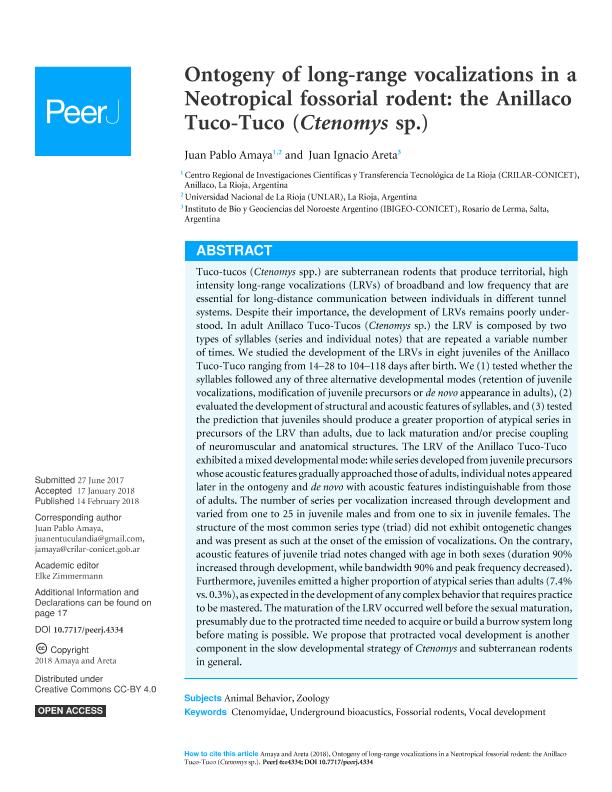Artículo
Ontogeny of long-range vocalizations in a Neotropical fossorial rodent: The Anillaco Tuco-Tuco (Ctenomys sp.)
Fecha de publicación:
02/2018
Editorial:
PeerJ Inc.
Revista:
PeerJ
ISSN:
2167-8359
Idioma:
Inglés
Tipo de recurso:
Artículo publicado
Clasificación temática:
Resumen
Tuco-tucos (Ctenomys spp.) are subterranean rodents that produce territorial, high intensity long-range vocalizations (LRVs) of broadband and low frequency that are essential for long-distance communication between individuals in different tunnel systems. Despite their importance, the development of LRVs remains poorly understood. In adult Anillaco Tuco-Tucos (Ctenomys sp.) the LRV is composed by two types of syllables (series and individual notes) that are repeated a variable number of times. We studied the development of the LRVs in eight juveniles of the Anillaco Tuco-Tuco ranging from 14-s28 to 104-118 days after birth. We (1) tested whether the syllables followed any of three alternative developmental modes (retention of juvenile vocalizations, modification of juvenile precursors or de novo appearance in adults), (2) evaluated the development of structural and acoustic features of syllables, and (3) tested the prediction that juveniles should produce a greater proportion of atypical series in precursors of the LRV than adults, due to lack maturation and/or precise coupling of neuromuscular and anatomical structures. The LRV of the Anillaco Tuco-Tuco exhibited a mixed developmental mode: while series developed from juvenile precursors whose acoustic features gradually approached those of adults, individual notes appeared later in the ontogeny and de novo with acoustic features indistinguishable from those of adults. The number of series per vocalization increased through development and varied from one to 25 in juvenile males and from one to six in juvenile females. The structure of the most common series type (triad) did not exhibit ontogenetic changes and was present as such at the onset of the emission of vocalizations. On the contrary, acoustic features of juvenile triad notes changed with age in both sexes (duration 90% increased through development, while bandwidth 90% and peak frequency decreased). Furthermore, juveniles emitted a higher proportion of atypical series than adults (7.4% vs. 0.3%), as expected in the development of any complex behavior that requires practice to be mastered. The maturation of the LRV occurred well before the sexual maturation, presumably due to the protracted time needed to acquire or build a burrow system long before mating is possible. We propose that protracted vocal development is another component in the slow developmental strategy of Ctenomys and subterranean rodents in general.
Palabras clave:
CTENOMYIDAE
,
FOSSORIAL RODENTS
,
UNDERGROUND BIOACUSTICS
,
VOCAL DEVELOPMENT
Archivos asociados
Licencia
Identificadores
Colecciones
Articulos(IBIGEO)
Articulos de INST.DE BIO Y GEOCIENCIAS DEL NOA
Articulos de INST.DE BIO Y GEOCIENCIAS DEL NOA
Citación
Amaya, Juan Pablo; Areta, Juan Ignacio; Ontogeny of long-range vocalizations in a Neotropical fossorial rodent: The Anillaco Tuco-Tuco (Ctenomys sp.); PeerJ Inc.; PeerJ; 2018; 2; 2-2018
Compartir
Altmétricas




